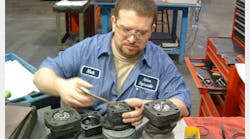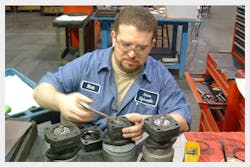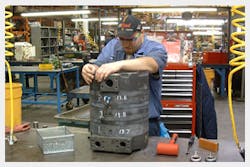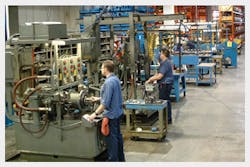The repair-rebuild-remanufacturing phenomenon has taken a strong grip on the fluid power industry in the 20th century and is here to stay through 21st century technology and beyond. The repair-rebuild concept depends upon durability and economic value. Certain types of engineering products — which are designed to be “throw-aways" — may not bring much economic value to the repair-rebuild process. Conversely, there are many products that can have a second life after the refurbishing process.
This article focuses on the repair-rebuild-remanufacturing concept in the fluid power industry — namely for hydraulic products — and will define repair, rebuild, and remanufacturing true to their sense.
Hydraulics requires precise, quality repair
Many repair processes could be termed as casual “rag-tag” operation, meaning that repaired components may not quite function as efficiently as the original one. Such repairs may be acceptable for non-engineering commodity type of products, but not for most precision hydraulic end products.
With evolving industries and technologies, repairing and rebuilding has become very common. Repaired, rebuilt components — or whole units — must function to near originality. The repair units not only should look like new, but must also perform like a new relevant one. Therefore, the aesthetic and engineering aspects are both a significantly important formula for an efficient repair-rebuild process.
Generally, the original designer or manufacturer should or must decide or spell out the extent of repair for a given product or components thereof. The original designer should put together the repair procedure and identify which components can be repaired, and which ones must not be repaired or refurbished.
In the past, among major hydraulic product manufacturers, only Vickers had come out with such an engineering-oriented procedure manual. However, such repair procedure manuals should be constantly reviewed for updated information because the extent of repair limits and changes with the advent of newer and current machining technologies. A good repair practice only enhances the image of manufacturers’ products because ultimately, no matter who repaired the product, it carries the original manufacturer’s identity and design value.
With the development of highly engineered pumps, motors, valves, and controls and related machine functions, it became necessary that repaired units and components perform with the same efficiency and adhere to form, shape, and function, like the original.
Taking ownership of hydraulic components and repairs
The hydraulic product field population dictates the repair market potential. The end equipment and machinery are scattered far away from manufacturers, all over the globe. End users will look for an alternate, economical, and quick responsive source to upkeep their equipment and machinery, for reduced downtime. At first, the end users may look to the original manufacturer’s for timely availability of the original parts and units. This is often not possible, as delivery lead-time or high prices may eliminate the possibility of buying new. Consequently, end users are left with one good option — to look for alternate, efficient and close by repair-rebuild sources. That is why there has been an emergence of hydraulic product repair–rebuilding houses. Coupling this with an economical rebuilding process has created a booming hydraulic product “repair-rebuild-remanufacturing” industry.
Different components require different care
A repairing function is not just cleaning, flushing, regrinding, and re-machining the parts and reassembling them to a full unit. There is more to it. Hydraulic products can be divided into three categories — dynamic, intermittent-dynamic, and static.
Dynamic products are those that are called for continuous function, such as hydraulic pumps. In a system, the pumps are likely to run at all times — not necessarily in load condition, but at an idle speed. Therefore, natural wear and tear in the mating components is far more common with in a given life span than other hydraulic products. Hence, pumps often have more frequent failure within and beyond the designed life span than other hydraulic products. For example, a rated 5 gpm pump at 1200 rpm and 100 psi runs all the time at 1200 rpm, even when the machine may not be in cycle or no-load condition. The duty cycle, design, and application determines the life span of a given pump, be it a piston, vane, or gear.
Intermittent–dynamic hydraulic units are those not required to run all the time in a system, such as hydraulic motors, directional valves, and servo proportional valves. In the majority of applications, these units do not run at all during the full cycle of the machine or equipment. Case in point — hydraulic motors, which most often run in a system only for a specific time period. The rest of the time the motor is sitting idle or not running at all. Of course there are a few exceptions, such as in conveyor belt applications.
Similarly, most sliding spool directional valves and other sliding spool functions do not run all the time in a system. Therefore, the motors and directional valves in a hydraulic system will have comparatively lower wear and tear than a hydraulic pump, over a given time period or duty cycle. The natural failure rates for such type of units are less than hydraulic pumps.
Static hydraulic products are those whose internal functions in a system are virtually “open-close” type. In other words, the internal components in such products have much less natural wear and tear, thus the life expectancy for such products is much longer than the other two categories of products. Pressure, flow, sequence and check valves, and inserts come under this category.
Finding the right service for each component
Repair — Simply said, a repair procedure is limited to making an old, failed component close to its original shape and size. All failed old components theoretically can be repaired but should not be because certain old failed components are beyond repairing and may not provide the full and desired function like the original. This is where the repairing procedure for every single component is so very crucial for the whole unit to function within its original specification.
In the hydraulic industry, a variety of products such as pumps, motors, valves, controls, and their parts thereof, could be repaired as long as the component dimensions, tolerances, and clearances are within the prescribed limit.
Rebuild — The term “re” comes out of doing it again. What this means is that a used, failed product first is dismantled, then the reasons for the failure and as well the failed components and parts are identified. The relevant unit is then built and assembled again with either new or “remanufactured” components and parts. The term “rebuilding” is very loosely used for a variety of activity.
Rebuilding of a hydraulic pump or motor can also be done with all relevant new components or parts. Therefore, just because the unit was rebuilt does not necessarily means that it is a “repaired” unit. Eventually, a rebuilt unit must go through the dynamic testing process. This ensures that the rebuilt unit has the same engineering specifications — in terms of flow, pressure, and leakage — as a new one.
Remanufacturing — The remanufacturing process has created all kinds of debate and confusion in the hydraulics service market. Remanufacturing functions can be divided into two areas — manufacturing on the existing core and “improved engineered.”
While working on the old core, it is necessary to ensure that the original dimensions are not distorted nor the material composition sacrificed. In many instances, after the surface finish and machining operations, heat and surface treatment is necessary, and then the component is completely finished. Such remanufactured components should possess the same mechanical quality as the original. Based on the component’s function in the whole unit, the extent of remanufacturing is decided. All old used components are not necessarily always accepted for remanufacturing.
Reengineered components are often “improved engineered” and are brand new. The re-engineering term is often called reversed engineering. Technically, qualified service houses often improve engineer the components and parts, to be used for rebuilding a complete pump/motor/valve unit. The reengineering process calls for creating a new drawing for the components, maintaining all the identical dimensions of the original one.
In many cases, the tolerances and clearances in the mating areas are tightened based on application and metallurgy, to improve efficiency and performance. For example, improving the fit between a vane pump ring, rotor, and vanes can improve volumetric efficiency. Tighter control of the fit between the vanes and their respective slots in the rotor can improve performance. In piston pumps and motors, improving the fit between the pistons and their respective bores in the cylinder block can improve both mechanical and volumetric efficiencies.
Valve tolerance and clearances can also be improved with reverse engineering. The tolerances and clearances between a spool OD and its respective bore in the valve body are applied with thorough technical knowledge of the product function, so that the finished product functions with the same efficiency as the original one.
Sometimes, such reversed engineered components or whole products are commonly called as “aftermarket” products. In reality the word “aftermarket” has nothing to do with such manufactured products.
Defining aftermarket
The word “aftermarket” comes out of the market potential for a given line of products, after the original was sold or marketed the first time.
Aftermarket is simply a market opportunity. It cannot be loosely used for a product, as often done. For example, say 10 injection molding machines were sold in the year of 2006. We shall say these 10 machines have 20 hydraulic pumps. The natural lives of these 20 pumps may be two years. Therefore, in 2008 these 10 machines could have generated a market potential for 20 pumps, to be repaired-rebuilt or replaced. This market potential is known as the “aftermarket.”
“Look alike” and “will-fit” terms are also often loosely used. The fact is, many original manufacturers’ product lines that have been declared obsolete by the manufacturer, but others reproduce them in support of market requirements. Most often these products’ patents have run out. Such products, manufactured by others, are often termed as “will-fit” or “look alike.” In reality, most often these products are built to original specifications and function like the original manufacturer’s.
Such products are like generic medicines. The ingredients in the product are just the same as the original. These products will have the branded names and most often are less expensive and available more quickly than the originals. Therefore, such branded hydraulic products could be cost effective as well as, as they maintain the productivity of the given machine and equipment, because the machine and the equipment do not have to be under breakdown for want of the product.
The bottom line of this massive industry is to reach out to the end users with a quality product in quickest possible time to reduce downtime and increase productivity, thereby giving profitability for everyone concern.
For more information, call (586) 949-4240 or visit www.ahx1.com.




